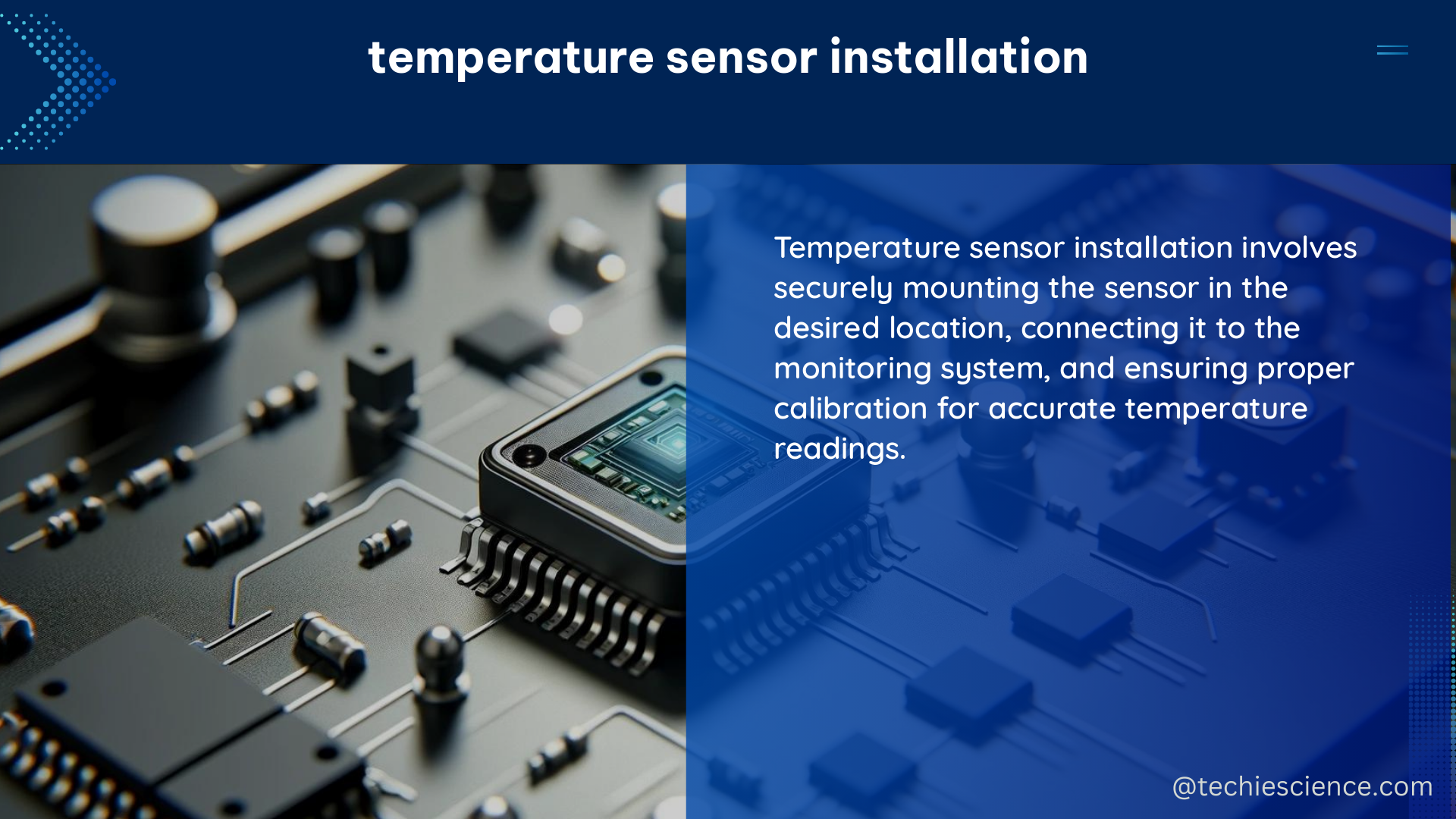Temperature sensor installation is a critical process that requires precise measurements and adherence to technical specifications. The sensor’s placement, type, and calibration significantly impact the accuracy of temperature data. Improper installation and environmental factors can lead to design, installation, and environment errors, affecting the overall measurement accuracy.
Understanding Temperature Sensor Types and Characteristics
When installing temperature sensors, it’s essential to consider the sensor’s sensitivity, accuracy, and response time. The three most common temperature sensor types are:
-
Thermocouples: Low-cost, long-lasting sensors that can measure a wide range of temperatures, from -200°C to 1,800°C. Thermocouples generate a small voltage proportional to the temperature difference between the measurement and reference junctions.
-
Resistance Temperature Detectors (RTDs): Slower than thermocouples and require an excitation current, but offer higher accuracy and stability. RTDs measure the change in electrical resistance of a metal (typically platinum) as the temperature changes.
-
Semiconductor-based Integrated Circuits: Simple to implant and can be packed in incredibly small packages. These sensors use the temperature-dependent behavior of semiconductor materials to measure temperature, with a typical range of -55°C to 150°C.
Each sensor type has unique characteristics and applications, and the choice depends on factors such as the required temperature range, accuracy, response time, and cost.
Sensor Placement and Installation Considerations

The placement of the temperature sensor is crucial for accurate measurements. Factors to consider include:
-
Distance from the Measured Object: The distance between the sensor and the measured object can introduce design errors, as the sensor may not accurately reflect the true temperature of the object.
-
Sensor Orientation: The orientation of the sensor can affect the heat transfer and, consequently, the temperature measurement. Proper alignment is essential to ensure accurate readings.
-
Thermal Coupling: The sensor should be in good thermal contact with the measured object to minimize thermal resistance and maximize heat transfer.
-
Environmental Factors: Ambient temperature, air flow, and other environmental conditions can lead to installation and environment errors, affecting the sensor’s performance.
To mitigate these factors, it’s essential to follow the manufacturer’s installation guidelines and consider the specific application requirements.
Calibration and Uncertainty Analysis
Calibration is a critical aspect of temperature sensor installation. It involves measuring the sensor’s resistance or voltage at different temperatures to estimate the total uncertainty of the measurement. The calibration report from the manufacturer is the first step in determining the accuracy of the temperature measurement.
However, other factors can also affect the measurement’s accuracy, including:
-
Design Errors: Errors introduced during the sensor design and manufacturing process, such as non-linearity, hysteresis, and sensitivity.
-
Installation and Environment Errors: Errors caused by improper installation, environmental conditions, and thermal coupling issues.
-
Operation and Instrumentation Errors: Errors introduced by the data acquisition system, signal conditioning, and other instrumentation components.
To quantify the total uncertainty of the temperature measurement, it’s essential to perform a comprehensive uncertainty analysis. This analysis should consider all the contributing factors and provide a detailed report on the overall measurement accuracy.
Practical Examples and Data Analysis
The search results provide several examples of measurable and quantifiable data related to temperature sensor installation and performance.
-
Thermocouple Installation and Temperature Data Analysis: The PDF document from the National Technical Reports Library discusses the installation of thermocouples and the analysis of temperature data, including figures that show the added frequency spectra for 45 days for accelerometers C2, C4, and C6 for thermocouple 16 at 10°C.
-
Temperature Measurement System Uncertainty: The Lake Shore Cryotronics document provides a detailed explanation of temperature measurement systems, including the total uncertainty of the measurement and the factors that can affect the accuracy of the temperature measurement. For example, the document states that the total uncertainty of a temperature measurement system can be as low as ±0.01°C for a high-quality platinum RTD sensor with a precision digital multimeter.
-
Sensor Performance Evaluation: The article from the Science Direct database presents a case study on the performance evaluation of temperature sensors, including the analysis of sensor response time, accuracy, and stability under different operating conditions.
These examples demonstrate the importance of quantifiable data and analysis in ensuring the accuracy and reliability of temperature sensor installations.
Conclusion
Temperature sensor installation is a complex process that requires careful consideration of the sensor’s type, placement, and calibration. By understanding the characteristics of different sensor types, adhering to best practices for sensor placement, and performing a comprehensive uncertainty analysis, you can ensure accurate and reliable temperature measurements.
The resources provided in this guide offer a wealth of technical details and quantifiable data to help you navigate the intricacies of temperature sensor installation. Whether you’re a DIY enthusiast or a professional in the field, this guide will serve as a valuable reference for your temperature sensor installation projects.
Reference:
- National Technical Reports Library. (n.d.). [PDF] Installation of Thermocouples and Analysis of Temperature Data. Retrieved from https://rosap.ntl.bts.gov/view/dot/49170/dot_49170_DS1.pdf
- Lake Shore Cryotronics. (n.d.). Appendix E: Temperature Measurement Systems. Retrieved from https://www.lakeshore.com/docs/default-source/temperature-catalog/lstc_appendixe_l.pdf?sfvrsn=b5177ae1_8
- Jiang, H., Ding, H., Jiang, Y., & Jiang, Z. (2022). Performance evaluation of temperature sensors based on machine learning. Expert Systems with Applications, 200, 117131. https://doi.org/10.1016/j.eswa.2022.117131

The lambdageeks.com Core SME Team is a group of experienced subject matter experts from diverse scientific and technical fields including Physics, Chemistry, Technology,Electronics & Electrical Engineering, Automotive, Mechanical Engineering. Our team collaborates to create high-quality, well-researched articles on a wide range of science and technology topics for the lambdageeks.com website.
All Our Senior SME are having more than 7 Years of experience in the respective fields . They are either Working Industry Professionals or assocaited With different Universities. Refer Our Authors Page to get to know About our Core SMEs.